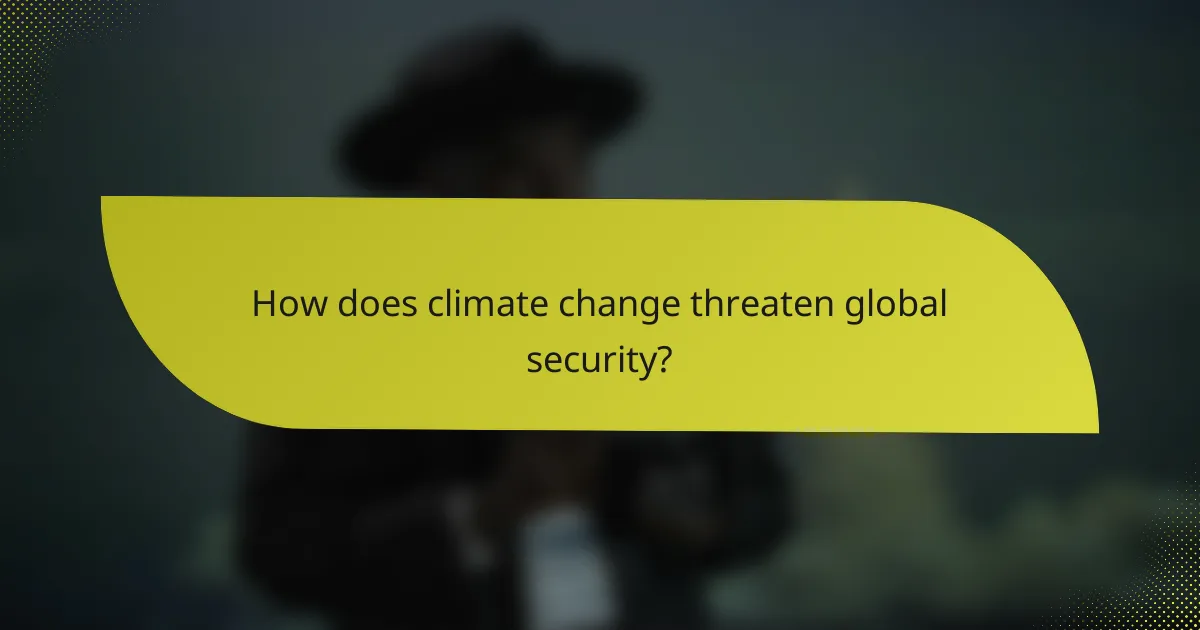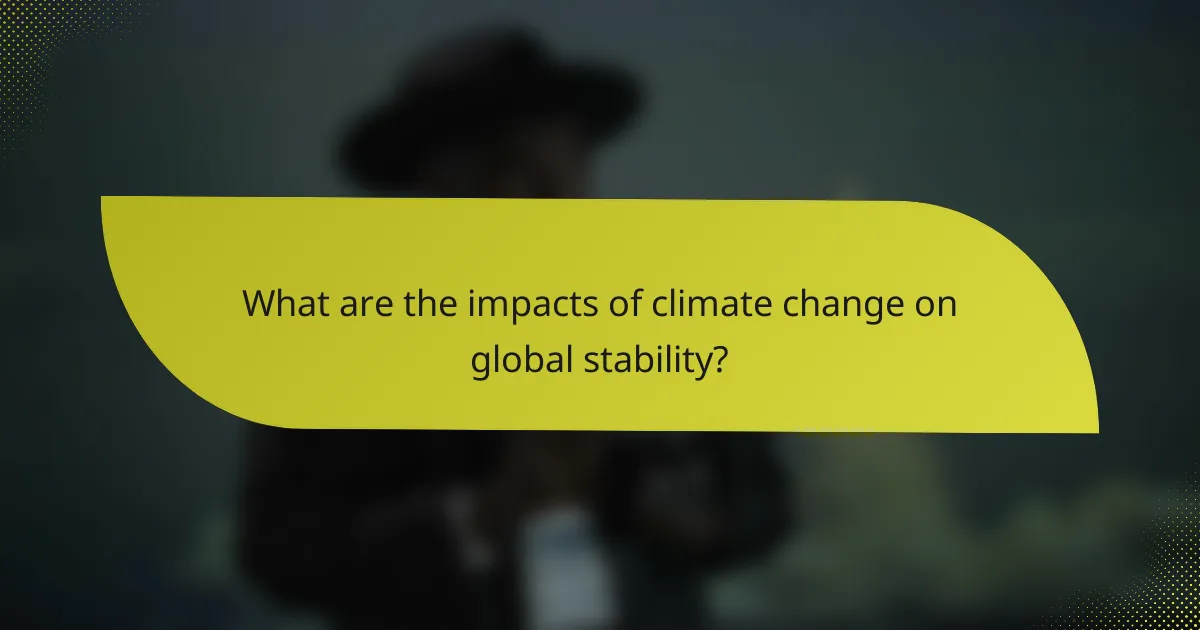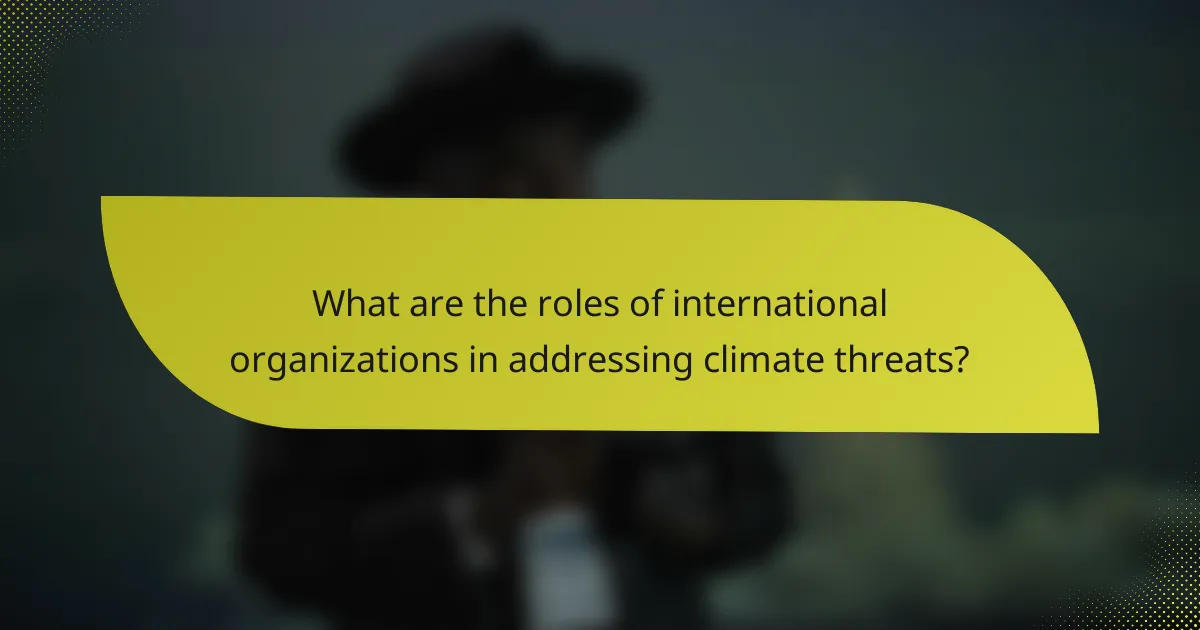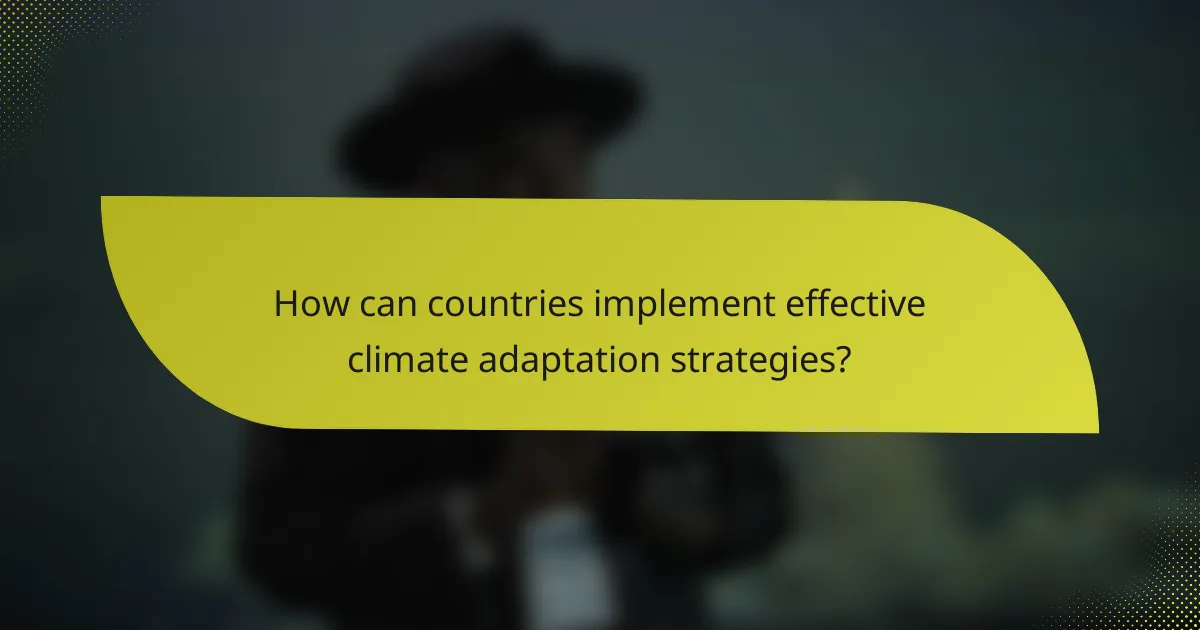Climate change is a critical security threat that intensifies natural disasters, resource scarcity, and geopolitical tensions, leading to instability and humanitarian crises. Its impacts extend beyond environmental concerns, triggering economic instability, migration crises, and public health risks that can result in social unrest. To address these challenges, nations must implement structured risk assessment frameworks that evaluate vulnerabilities and adapt to evolving conditions.

How does climate change threaten global security?
Climate change poses significant threats to global security by exacerbating natural disasters, increasing resource scarcity, and heightening geopolitical tensions. These factors can lead to instability, conflict, and humanitarian crises across various regions.
Increased natural disasters
Climate change leads to more frequent and severe natural disasters, such as hurricanes, floods, and wildfires. These events can devastate communities, displace populations, and overwhelm emergency response systems.
For instance, regions like Southeast Asia and the Caribbean are experiencing intensified storms, resulting in substantial economic losses and humanitarian needs. Countries must invest in disaster preparedness and resilient infrastructure to mitigate these impacts.
Resource scarcity
As climate change alters weather patterns, essential resources like water and arable land become increasingly scarce. This scarcity can drive competition among nations and communities, leading to conflicts over access to these vital resources.
In areas such as the Middle East and North Africa, prolonged droughts are diminishing water supplies, which can exacerbate existing tensions and lead to unrest. Effective management and equitable distribution of resources are crucial to prevent conflicts arising from scarcity.
Geopolitical tensions
Climate change can exacerbate geopolitical tensions as nations grapple with the impacts of environmental changes on their security. Disputes over borders, resource access, and migration can intensify as countries respond to climate-induced challenges.
For example, melting Arctic ice is opening new shipping routes and access to natural resources, prompting competition among Arctic nations. Diplomatic efforts and international cooperation are essential to address these emerging tensions and promote stability.

What are the impacts of climate change on global stability?
Climate change significantly threatens global stability by exacerbating economic instability, triggering migration crises, and increasing public health risks. These impacts can lead to social unrest and geopolitical tensions, affecting nations worldwide.
Economic instability
Climate change can disrupt economies by damaging infrastructure, reducing agricultural productivity, and increasing the frequency of extreme weather events. For instance, countries reliant on agriculture may face crop failures, leading to food shortages and rising prices.
In addition, the costs of adapting to climate change, such as investing in resilient infrastructure, can strain national budgets. This economic pressure may lead to increased debt or reduced public services, further destabilizing affected regions.
Migration crises
As climate change impacts worsen, many people may be forced to migrate due to uninhabitable conditions, such as rising sea levels or extreme droughts. This mass movement can create significant challenges for both the migrants and the host countries, leading to tensions over resources and social integration.
Regions particularly vulnerable to climate-induced migration include low-lying coastal areas and drought-prone regions. Countries in Europe and North America may see increased migration from affected areas, necessitating policies to manage these demographic shifts effectively.
Public health risks
Climate change poses serious public health risks by increasing the prevalence of diseases and exacerbating health disparities. Warmer temperatures can expand the range of vector-borne diseases, such as malaria and dengue fever, putting more populations at risk.
Additionally, extreme weather events can lead to mental health issues and injuries, while air pollution from increased temperatures can worsen respiratory conditions. Health systems may struggle to cope with these challenges, particularly in low-income countries with limited resources.

How can nations assess climate-related risks?
Nations can assess climate-related risks by employing structured frameworks that evaluate vulnerabilities and potential impacts. This process involves gathering relevant data, collaborating with various stakeholders, and continuously updating assessments to reflect changing conditions.
Risk assessment frameworks
Risk assessment frameworks provide a systematic approach for evaluating climate-related threats. Common models include the Intergovernmental Panel on Climate Change (IPCC) guidelines and the United Nations Framework Convention on Climate Change (UNFCCC) methodologies. These frameworks typically involve identifying hazards, assessing exposure, and evaluating the potential consequences on communities and economies.
Countries should consider integrating local context into these frameworks, such as specific geographic vulnerabilities and socio-economic factors. For example, coastal nations might prioritize assessments of rising sea levels and storm surges, while landlocked countries may focus on drought and food security.
Data collection methods
Effective data collection methods are crucial for accurate climate risk assessments. Nations can utilize satellite imagery, weather stations, and climate models to gather relevant information. Additionally, citizen science initiatives can enhance data collection by involving local communities in monitoring environmental changes.
It is essential to ensure that data is both reliable and accessible. Countries should aim for a combination of quantitative data, such as temperature changes, and qualitative data, like community feedback on climate impacts. This mixed-method approach can provide a more comprehensive understanding of risks.
Collaboration with NGOs
Collaboration with non-governmental organizations (NGOs) can significantly enhance climate risk assessments. NGOs often have specialized knowledge, resources, and networks that can aid in data collection and analysis. Partnering with these organizations can also facilitate community engagement and increase public awareness of climate issues.
Countries should seek to establish formal partnerships with NGOs that focus on environmental sustainability and disaster preparedness. This collaboration can lead to more effective risk communication strategies and better-informed policy decisions, ultimately strengthening national resilience to climate-related threats.

What are the roles of international organizations in addressing climate threats?
International organizations play a crucial role in addressing climate threats by facilitating cooperation, providing funding, and implementing strategies to mitigate climate impacts. They help nations align their policies and actions to combat climate change effectively.
United Nations initiatives
The United Nations (UN) has spearheaded numerous initiatives aimed at combating climate change, most notably through the Paris Agreement. This landmark accord encourages countries to set and achieve nationally determined contributions (NDCs) to reduce greenhouse gas emissions.
Additionally, the UN Framework Convention on Climate Change (UNFCCC) hosts annual conferences where nations negotiate and assess progress. These gatherings foster collaboration and accountability among member states, promoting shared goals and strategies.
NATO’s climate strategy
NATO recognizes climate change as a significant security threat that can exacerbate instability and conflict. The alliance has integrated climate considerations into its strategic planning, focusing on resilience and adaptation in military operations.
Through initiatives like the NATO Climate Change and Security Action Plan, the organization aims to enhance member nations’ capabilities to address climate-related risks. This includes assessing vulnerabilities and developing strategies to mitigate potential impacts on security and defense.
World Bank funding
The World Bank provides substantial funding to support climate resilience projects in developing countries. By offering financial resources and technical assistance, the Bank helps nations implement sustainable practices and adapt to climate impacts.
Funding initiatives often focus on renewable energy, sustainable agriculture, and disaster risk management. The World Bank also emphasizes the importance of integrating climate considerations into national development plans to ensure long-term sustainability and stability.

How can countries implement effective climate adaptation strategies?
Countries can implement effective climate adaptation strategies by focusing on enhancing infrastructure resilience, enacting supportive policy reforms, and fostering community engagement. These approaches help mitigate the impacts of climate change and ensure sustainable development.
Infrastructure resilience
Building infrastructure resilience involves designing and upgrading facilities to withstand climate-related stresses such as flooding, heatwaves, and storms. This can include using durable materials, elevating structures in flood-prone areas, and incorporating green infrastructure like parks and wetlands.
For example, cities can invest in stormwater management systems that reduce flooding risks, potentially saving millions in damages. Regular assessments and updates to infrastructure standards are essential to adapt to evolving climate conditions.
Policy reforms
Effective climate adaptation requires comprehensive policy reforms that integrate climate considerations into all levels of governance. This can involve revising zoning laws, enhancing building codes, and promoting sustainable land use practices.
Countries should prioritize policies that incentivize renewable energy, improve energy efficiency, and support climate-resilient agriculture. Engaging stakeholders in the policy-making process ensures that reforms are practical and widely supported.
Community engagement
Community engagement is crucial for successful climate adaptation strategies. Involving local populations in decision-making fosters ownership and ensures that initiatives meet the specific needs of communities affected by climate change.
Governments can facilitate workshops, public forums, and educational campaigns to raise awareness about climate risks and adaptation measures. Collaborating with local organizations can enhance outreach and effectiveness, leading to more resilient communities.
